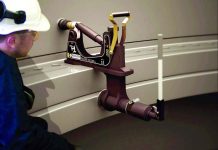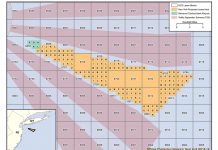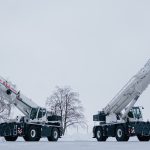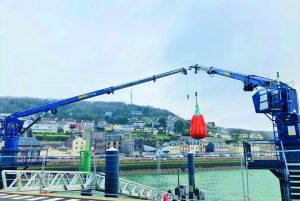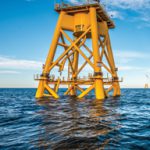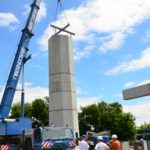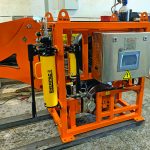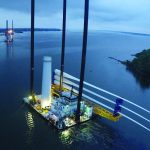Wind energy has come a long way in Chile since the first wind farm was inaugurated in 2001, the Alto Baguales, a three-turbine farm that generated 2 MW of energy. Today, Chile has over 300 MW of wind power generation capacity, and the recently inaugurated Valle De Los Vientos park at the northern Chilean region of Antofagasta accounts for 90 MW. Valle De Los Vientos is the first of three wind farms planned for this region. With the other two already approved, the Calama joint wind farm will have 240 MW capacity and a total investment of more than $500 million. To erect this new generation wind farm, developer Enel GreenPower requested lifting services of Gruas Burger and their Terex CC 2800-1 NT crawler crane.
Erecting wind turbines is somewhat a dichotomy: one has to build the turbines where there is wind, but one can seldom perform lifts with strong wind speeds. Complicating the matter even more is the fact that one has to take into consideration the wind sail area when lifting large surface components. If all this comes together, the window to perform the lifts might be small, and lift companies must be ready to act when it opens. When building an entire wind park comprised of 45 turbines, these variables add up and can bog down a project or significantly increase its costs. Figure 1
Gruas Burger came to prominence worldwide relative recently for being the crane rental company that supplied the cranes to rescue the 33 miners trapped at a mine in the north of Chile. Not only has this crane and transport company been around since 1996, but it also is no stranger to the hostile climatic conditions of the Chilean Desert, where hot temperatures and high altitudes are everyday working conditions. It was natural that they were the right company to erect a large wind park in the north of Chile.
Planning and erecting a wind park has its idiosyncrasies. Besides transporting the turbines, building the foundations and erecting them, an often-overlooked aspect for this type of project is site preparation. Access roads, lifting pads, and support facilities need to be built from scratch, often in remote areas like this one. On top of this, the variability in climatic conditions when the turbines can be erected meant that the project has a high potential for delays and cost increases. To mitigate these risks, it was important to be efficient in planning, and be reliable when lifting.
Efficiency in Ground Preparation
“Ground preparation is very important when performing lifts, and it’s an aspect one should never skimp on, but there are ways to minimize costs in projects like this,” said Raul Burger, president and owner of Gruas Burger. “We are very experienced in erecting wind turbines, so we offered the developing company our services with the NT crane so they only needed to build 5.5-meter-wide roads for the crane instead of 10 meters, which is usually needed for a crawler crane. We helped them save a significant amount of money.”
Whereas the track footprint of the conventional Terex CC 2800-1 crawler crane measures over 32 ft (9 m), the track width of the Terex CC 2800-1 NT is only 17.4 ft (5.3 m), allowing Burger’s crews to navigate the narrow roads. Even with the narrow tracks, the crane still offers the high lift capacities customers expect from a 660-ton crane. Large 16.4 ft long x 4.6 ft wide (5 x 1.4 m) front/rear outrigger pads work in conjunction with two hydraulically operated 9.8 x 7.9 ft (3 x 2.4 m) side outrigger pads to give the stability required for lifting heavy loads. Figure 2
Heart-Stopping Construction Pace
The pace at which this wind farm was built was outstanding by any standard, according to Raul Burger. “It was a logistic masterpiece we are proud of. After the access roads and pads were prepared, and the turbine parts in place, we erected each turbine and then crawled with the fully erected crane to the next pad. On average we erected one turbine per day and each turbine required seven lifts. It was indeed a very fast pace.”
The Valle De Los Vientos wind farm is comprised of 45 Vestas V100/2000 2 MW turbines with a rotor diameter of 100m. To erect these type of turbines, the crane had to lift loads up to 100 tons up to a height of 80 meters with a usual working radius of 18 meters.
“After 2 months of hard work, we lifted the last nacelle. It was a wonderful feeling to look back and see how much we contributed towards renewable power in Chile in such a short time,” Raul Burger said.
The Terex CC 2800-1 NT crawler crane offers a high return on investment and is among the most economical and versatile narrow track cranes in the 660 US ton class. Using a selection of specially designed accessories, the crane is convertible from standard heavy lift configuration to a narrow track crane and back, providing outstanding performance in a wide variety of applications, including wind farm sites, where extra heavy load capacity is a necessity. Figure 3
Recognizing the high potential of the onshore wind turbine market and the subsequent need for dedicated equipment in the 660 US ton class, Terex Cranes developed the CC 2800-1 NT (narrow track) crane model from the standard CC 2800-1 version to suit specific wind farm construction requirements. Equipped with its narrow track chassis, the CC 2800-1 NT can be driven from one construction site to the next, even when access is tight, while fully rigged with counterweights, 334.6 ft. (102 m) main boom and LF 2 fixed jib, saving precious time and increasing productivity.
The CC 2800-1 NT version is based on a conventional CC 2800-1 crawler crane, where the standard chassis (27.6 ft {8.4 m} track width) is replaced with the Narrow Track Kit comprising of: chassis track with 5.3 m outer track width and front and rear outriggers, two 16.4 ft long x 4.6 ft wide (5 x 1.4 m) outrigger pads for both front and rear outriggers, two side outriggers with 9.8 x 7.9 ft (3 x 2.4 m) outrigger pads, counterweight suspension frame to lower the center of gravity and control system with remote control unit and full color graphic display monitor at the rear of the crane chassis. To provide stability and quick rigging times, both front and rear outrigger beams remain connected to the carrier.
—Source: Terex Cranes
















